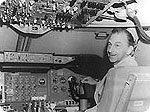The legend who brought the air age to India
The
message from Air Ind
28 July 2004
Jehangir Ratanji Dadabhoy Tata, popular as JRD, gave wings to the nation and established its civil aviation. A tribute by Shubha Madhukar
"He touched the sky,
and it smiled.
He stretched out his arms
And they encircled the globe.
His vision made giants out of
Men and organisations."
 The message from Air India on the death of JRD, the person who dreamt of, and realised, civil and commercial aviation in India, couldn't have been more evocative. The words not merely pay homage to the person and aviator, but also aptly describes the passion and essence of JRD's life and times.
The message from Air India on the death of JRD, the person who dreamt of, and realised, civil and commercial aviation in India, couldn't have been more evocative. The words not merely pay homage to the person and aviator, but also aptly describes the passion and essence of JRD's life and times.
JRD's rendezvous with aviation began when he was just five. In France, where he grew up, his neighbour was Louis Bleriot, the famous aviator — the first person to fly across the English Channel in 1909. Jeh, as JRD was affectionately called, grew up fascinated with Bleriot's aircrafts, which led to a lifelong passion for flying. Clearly, during his formative years, Bleirot was his hero.
In 1919, when he was 15, JRD had his first joyride. It stirred and enchanted him. It was then that he decided to become a pilot. His resolve was realised nine years later when at the age of 24, JRD passed out of the Bombay Flying Club. Incidentally, JRD was the first Indian to become a commercial pilot. His aviator's certificate in blue and gold bears the number '1' and is dated February 10, 1929.
Flying was a childhood passion for him. In 1982, he said to a gathering in Mumbai, "Right from childhood I have been mad about flying and anxiously waited for the day when I would fly myself." It was probably this early passion that led him to dream of building a national air carrier for India.
